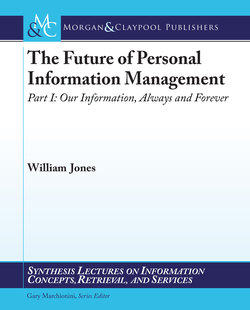Читать книгу The Future of Personal Information Management, Part 1 - William Jones - Страница 12
На сайте Литреса книга снята с продажи.
ОглавлениеCHAPTER 2
The Basics of PIM
In our practices of PIM, we are (or should be) in charge. In sentences describing our behavior, we’re the subject. That’s the “P” in PIM. The object of these sentences is information in one form or another—the “I” in PIM. And the verb is some PIM activity—the “M.”
This chapter concerns basics of the “I” and the “M” of PIM. The first section, on the way to defining a space of personal information, considers what it means for information to be manageable and some of the “whys” for doing so. The second section considers basic activities of PIM and the mapping between information and need that is realized (implicitly) through these activities.
2.1 INFORMATION AS THE OBJECT OF PIM
In Chapter 1, Buckland is quoted as saying “we are unable to say confidently of anything that it could not be information”79. We can’t manage it all. However, Buckland offers a useful slant on “information-as-thing” which fits nicely with the derivation of “management.” The word comes from “manage” which derives from the Latin “manus”—hand80. PIM is focused on the information we “touch” and manipulate—if not directly, as we do for paper-based forms of information, then at least indirectly through our information tools.
2.1.1 THE INFORMATION ITEM AND ITS FORM
Information-as-thing is something tangible to be manipulated—to be created, copied, stored, retrieved; given a name, tags, and other properties; and moved, copied, distributed, deleted, and otherwise transformed. In this spirit, it is useful to speak of an information item and its associated form:
An information item is a packaging of information. Examples of information items include: 1. paper documents, 2. electronic documents, digital photographs, digital music, digital film and other files, 3. email messages, 4. web pages or 5. references (e.g., shortcuts, aliases) to any of the above. Items encapsulate information in persistent forms that can be created, modified, stored, retrieved, given a name, tags and other properties, moved, copied, distributed, deleted and otherwise manipulated.
For a information item it is often useful to speak of an associated information form which is determined by the tools and applications that support the operations listed above. Common forms of information include paper documents, e-documents and other files, email messages and web bookmarks81.
